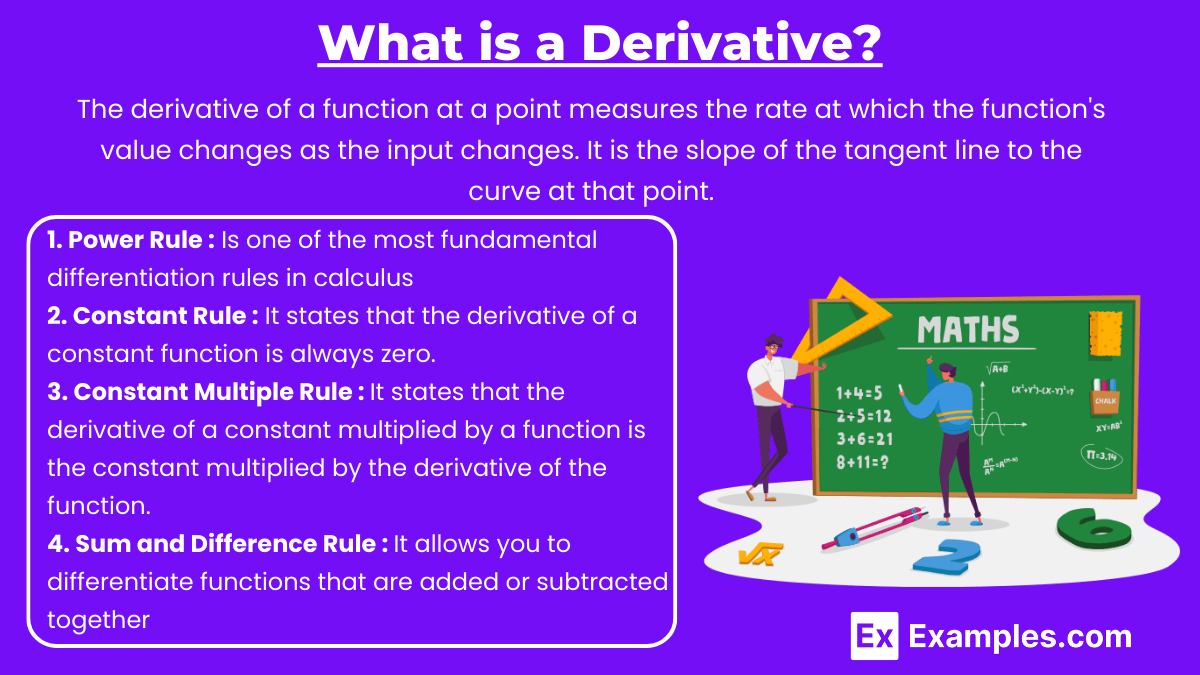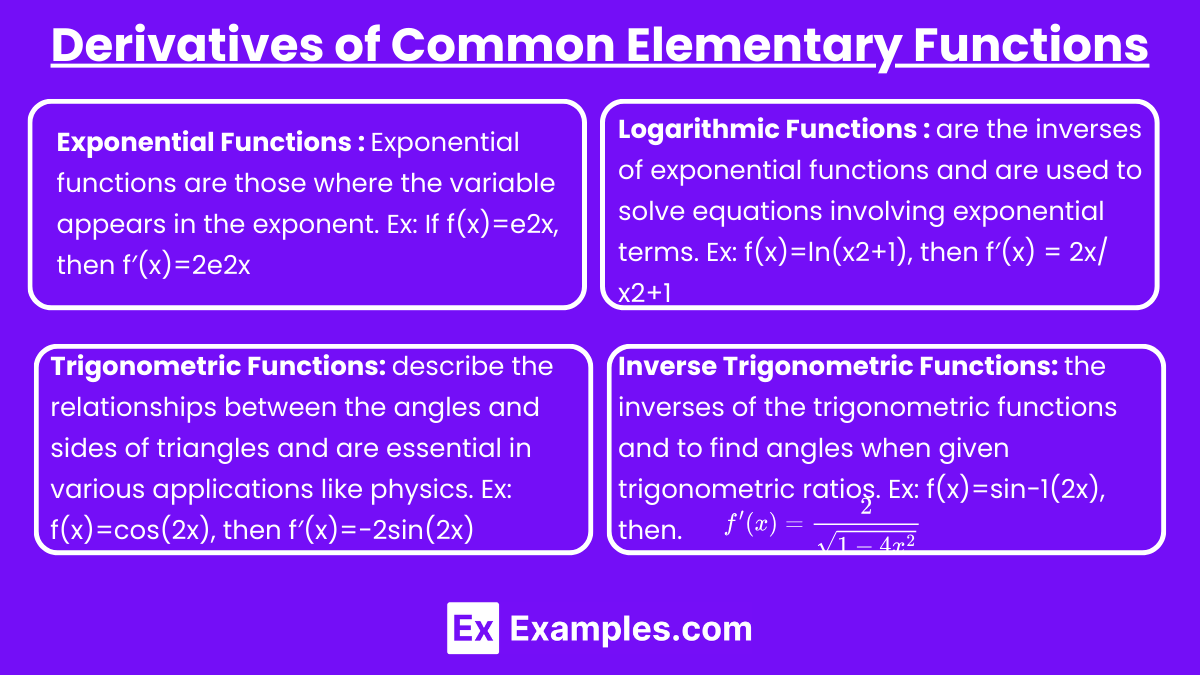Determining derivatives for elementary functions is a foundational skill in both AP Calculus AB and BC. This topic involves understanding and applying differentiation rules to functions such as polynomials, exponentials, logarithms, trigonometric, and inverse trigonometric functions. Mastery of these techniques allows students to analyze rates of change, optimize functions, and solve complex calculus problems. For both AB and BC exams, a solid grasp of these concepts is essential for tackling a wide range of questions with confidence and accuracy.
Learning Objectives
By studying the topic of Determining Derivatives for Elementary Functions for the AP Calculus AB and BC exams, you should be able to confidently apply differentiation rules to polynomial, exponential, logarithmic, trigonometric, and inverse trigonometric functions. You should master the Power, Product, Quotient, and Chain Rules, and understand how to differentiate composite functions. Additionally, you should be proficient in higher-order derivatives, implicit differentiation, and applying these skills to solve real-world problems and analyze the behavior of functions.
What is a Derivative?

The derivative of a function at a point measures the rate at which the function’s value changes as the input changes. It is the slope of the tangent line to the curve at that point. Mathematically, the derivative of a function f(x) at a point x=a is given by:
Basic Differentiation Rules
1. Power Rule : The Power Rule is one of the most fundamental differentiation rules in calculus. It applies to functions where the variable x is raised to a constant power n.
Formula: If f(x) = xn, where n is any real number, then the derivative is: f′(x) = nxn−1
This rule works for both positive and negative powers, as well as fractional exponents.
Example: If f(x) = x3, then f′(x) = 3x2.
2. Constant Rule: The Constant Rule states that the derivative of a constant function is always zero. This is because a constant function does not change, so its rate of change (slope) is zero.
Formula: If f(x) = c, where c is a constant, then:
f′(x) = 0
Example: If f(x)=5, then f′(x)=0.
3. Constant Multiple Rule : The Constant Multiple Rule states that the derivative of a constant multiplied by a function is the constant multiplied by the derivative of the function. This rule allows you to “factor out” the constant when differentiating.
Formula: If f(x) = c⋅g(x), where c is a constant and g(x) is a differentiable function, then:
f′(x) = c⋅g′(x)
Example: If f(x) = 7x4, then f′(x) = 7⋅4x3 = 28x3.
4. Sum and Difference Rule : The Sum and Difference Rule allows you to differentiate functions that are added or subtracted together by differentiating each function individually and then combining the results.
Formula: If f(x) = g(x)±h(x), where both g(x) and h(x) are differentiable functions, then:
f′(x) = g′(x)±h′(x)
Example: If f(x) = x3+2x2, then f′(x) = 3x2+4x.
Derivatives of Common Elementary Functions

1. Exponential Functions
Exponential functions are those where the variable appears in the exponent. They are commonly used in modeling growth and decay processes, such as population growth or radioactive decay.
Key Points:
- The base e (approximately 2.718) is special because the derivative of ex is ex itself, which makes it unique and widely used in calculus.
- For a general exponential function with base a, the derivative includes a natural logarithm of the base a, reflecting how the growth rate scales with different bases.
Additional Examples:
- If f(x) = e2x, then f′(x) = 2e2x.
- If f(x) = 5x, then f′(x) = 5xln(5).
- If f(x) = 32x, then f′(x) = 2⋅32xln(3).
2. Logarithmic Functions
Logarithmic functions are the inverses of exponential functions and are used to solve equations involving exponential terms. They have important properties that make them useful in various applications, such as solving for time in exponential growth models.
Key Points:
- The derivative of the natural logarithm function ln(x) is simple and elegant, as it is the reciprocal of x.
- For logarithms with bases other than e, the derivative involves dividing by x and multiplying by the natural logarithm of the base.
Additional Examples:
- If f(x) = ln(5x), then f′(x) = 1/5x ⋅ 5 = 1/ x.
- If f(x) = log3(x), then f′(x) = 1 / xln(3).
- If f(x) = ln(x2+1), then f′(x) = 2x/ x2+1.
3. Trigonometric Functions
Trigonometric functions describe the relationships between the angles and sides of triangles and are essential in various applications like physics, engineering, and signal processing.
Key Points:
- The derivatives of sine and cosine functions are straightforward and reflect the cyclical nature of these functions.
- Tangent, cotangent, secant, and cosecant have more complex derivatives, which are crucial in problems involving waveforms and oscillations.
Additional Examples:
- If f(x) = cos(2x), then f′(x) = −2sin(2x).
- If f(x) = tan(3x), then f′(x) = 3sec2(3x).
- If f(x) = csc(x), then f′(x) = −csc(x)cot(x).
4. Inverse Trigonometric Functions
Inverse trigonometric functions are the inverses of the trigonometric functions and are used to find angles when given trigonometric ratios. These derivatives are important in integration and solving equations involving trigonometric functions.
Key Points:
- The derivatives of inverse trigonometric functions often involve square roots, which relate to the geometric interpretation of these functions.
- These derivatives are vital in problems where you need to reverse the trigonometric relationships, such as in solving for angles in right triangles.
Additional Examples:
- If f(x) = sin−1(2x), then
.
- If f(x) = sec−1(x), then
.
- If f(x) = cot−1(x), then
.
These functions and their derivatives are essential tools in calculus, and understanding them is crucial for success in the AP Calculus AB and BC exams. Make sure to practice these derivatives in various contexts to fully grasp their applications.
Examples
Example 1: Derivative of a Polynomial Function:
Example 2: Derivative of an Exponential Function
Example 3: Derivative of a Trigonometric Function
Example 4: Derivative of a Logarithmic Function
Example 5: Derivative of a Radical Function
Multiple Choice Questions
Question 1
Given the function f(x) = 3x4−5x2+7, what is the derivative f′(x)?
A) 12x3−10x
B) 12x3−5x
C) 4x3−10x
D) 4x3−5x
Answer: A) 12x3−10x
Explanation: To find the derivative f′(x) of the function f(x) = 3x4−5x2+7, apply the power rule, which states that the derivative of axn is n⋅axn−1.
- For the first term 3x4, the derivative is 4⋅3x4−1=12x3.
- For the second term −5x2, the derivative is 2⋅(−5)x2−1=−10x.
- The third term 7 is a constant, and the derivative of a constant is 0.
Thus, the derivative f′(x)=12x3−10x.
Question 2
What is the derivative of the function g(x) = ln(x)?
A) 1/x
B) xln(x)
C) x
D) 1/x2
Answer: A) 1/x
Explanation: The derivative of the natural logarithm function ln(x) with respect to x is 1/x. This is a standard result in calculus, where the derivative of ln(x) is always 1/x for x>0.
Question 3
Find the derivative of the function h(x) = sin(x)+cos(x).
A) cos(x)−sin(x)
B) cos(x)+sin(x)
C) −cos(x)−sin(x)
D) sin(x)−cos(x)
Answer: A) cos(x)−sin(x)
Explanation: To differentiate the function h(x) = sin(x)+cos(x), use the standard derivatives of the sine and cosine functions:
- The derivative of sin(x) is cos(x).
- The derivative of cos(x) is −sin(x).
Thus, the derivative h′(x) is cos(x)−sin(x).


